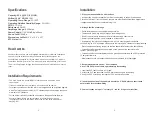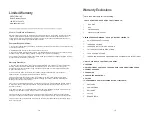
Capacity: 60 L @ 30˚C, 80% RH
Operating Relative Humidity Range:
36%-90%
Amperage Usage:
6.82 Amps
Sound Level:
60 dBa
Airflow @ 0.0” SP:250
CFM
COP:
2.7 L/kWh
Power Supply:
115V/60Hz/Single Phase
Dimensions LxWxH:
13.8” x 15.8” x 23.7”
Operating Temp. Range:
33-105°F
Refrigerant:
R410A
ETL Listed:
Yes
Specifications
How
it
works
Installation Requirements
Abestorm dehumidifiers use an integrated humidistat to monitor the conditioned
space. When the relative humidity goes above the selected setpoint, the
dehumidifier will energize. Air is then drawn across an evaporator coil, which is
cooler than the dew point of air. This means moisture will condense out of the air.
The air is then reheated through the condenser coil and distributed back into the
room.
If the unit is installed in a crawl space, all vents should be sealed.
The
area
where
the
dehumidifier
is
located
should
be
sealed
with
a
vapor
barrier
.
For proper ventilation, neither the inlet or discharge should be positioned against
a wall. The inlet needs a minimum of 12” clearance and the discharge requires a
minimum of 36” clearance.
Abestorm dehumidifiers are only intended for operation when the unit
is upright and level with the feet on the ground (unless using a Abestorm
Hanging Kit).
For the best air diffusion, install the unit so that a side panel faces the wall.
Installation
•
avoid putting it against a vapor barrier. Don’t use anything to support it at the base.
Place it on the floor. If your device was place in any other position other than upright place
it upright and allow two hours before turning it on.
1.
Place your dehumidifier on a flat surface,
•
•
Route the drain hose to a suitable drainage outside
There should not be any loops or dips on the drainage hose
2
.
Arrange the line of drainage
3. Recommended drain choice – PVC transition
Cut a ¾ OD PVC piece of cable, approximately 6inches long
•
Seal of the point where the dehumidifier is located using a vapor barrier
•
Seal off all openings if the unit is installed in a crawl space
•
Avoid placing the inlet and outlet against a wall. This ensures proper ventilation.
You need to give a 12’’ allowance of space with the inlet and 36’’ clearance for the discharge
•
Place the side panel facing the wall so that the dehumidifier delivers the best diffusion
•
Your dehumidifier is designed to be placed on the ground at the same level with
the feet. Place it upright
•
Your dehumidifier unit should always have a grounded connection with a GFCI protected
15 amp electrical wire.
•
Maintenance should be conducted with the power switched off or unplugged.
1.
2.
Insert the PVC that is cut into a ¾’’ elbow.
Attach the PVC and the elbow to a PVC drain measuring 3/4 inches long
3. Keep the PVC short. Keep the length of PVC as short as possible
4. Insert the open side of the unit drain hose into a 6’’ PVCA piece so that it does
not protrude into the elbow fitting
5. Your unit needs a slop of 1’’ for every 10 ‘’ run for it to get a correct flow
3
2









